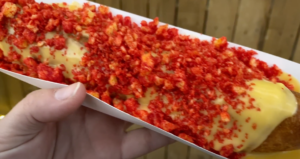Oahu, the vibrant heart of Hawaii, is known for its rich blend of cultural influences, which is especially reflected in the island’s food scene. When it comes to local eats during events like the Oahu Rodeo, the cuisine takes on a distinctly Hawaiian flair, with a focus on fresh ingredients, hearty flavors, and traditional dishes that have been passed down through generations. A visit to the Oahu Rodeo isn’t just about watching the action; it’s also an opportunity to savor some of the most beloved foods that are staples of island life.
Local Favorite Reigns Supreme
 Pork is undoubtedly one of the most important and cherished components of Hawaiian cuisine. For centuries, it has been a staple of local diets and plays a central role in both everyday meals and special occasions. One of the most iconic ways pork is prepared in Hawaii is through a cooking method known as “kalua,” which involves slow-cooking a whole pig in an underground oven called an imu. This method infuses the pork with a rich smoky flavor, making it incredibly tender and flavorful. At the Oahu Rodeo, kalua pork is a common dish served, often shredded and paired with rice and a side of poke, a traditional raw fish salad, creating a hearty and satisfying meal. This method of cooking pork reflects both the historical roots of Hawaiian culture and the influence of Polynesian culinary traditions.
Pork is undoubtedly one of the most important and cherished components of Hawaiian cuisine. For centuries, it has been a staple of local diets and plays a central role in both everyday meals and special occasions. One of the most iconic ways pork is prepared in Hawaii is through a cooking method known as “kalua,” which involves slow-cooking a whole pig in an underground oven called an imu. This method infuses the pork with a rich smoky flavor, making it incredibly tender and flavorful. At the Oahu Rodeo, kalua pork is a common dish served, often shredded and paired with rice and a side of poke, a traditional raw fish salad, creating a hearty and satisfying meal. This method of cooking pork reflects both the historical roots of Hawaiian culture and the influence of Polynesian culinary traditions.
Other Popular Foods at the Rodeo
 While kalua pork is a standout, Oahu’s rodeo eats include a variety of dishes that represent both traditional Hawaiian flavors and contemporary twists. Hawaiian-style BBQ is always a crowd-pleaser, with meats like beef, chicken, and pork being grilled over an open flame and glazed with savory-sweet sauces. The BBQ plates are often served with classic sides such as macaroni salad, rice, and grilled vegetables. Another must-try dish is loco moco, which features a scoop of rice topped with a hamburger patty, a fried egg, and smothered in brown gravy—a deliciously comforting plate that is popular across the islands.
While kalua pork is a standout, Oahu’s rodeo eats include a variety of dishes that represent both traditional Hawaiian flavors and contemporary twists. Hawaiian-style BBQ is always a crowd-pleaser, with meats like beef, chicken, and pork being grilled over an open flame and glazed with savory-sweet sauces. The BBQ plates are often served with classic sides such as macaroni salad, rice, and grilled vegetables. Another must-try dish is loco moco, which features a scoop of rice topped with a hamburger patty, a fried egg, and smothered in brown gravy—a deliciously comforting plate that is popular across the islands.
Another beloved food is spam musubi, a unique take on sushi where a slice of grilled Spam is placed on top of a block of rice and wrapped in seaweed. This snack is widely enjoyed in Hawaii and is a common sight at rodeos and other outdoor events, offering a quick and tasty bite between the action. Shave ice is also a popular treat to enjoy in the heat, with colorful syrup drizzled over finely shaved ice, offering a refreshing and sweet way to cool down.
Don’t Forget The Pork!
In Hawaiian cuisine, pork temp meat refers to a specific type of marinated and sometimes dried pork that is commonly prepared for use in various dishes. The pork is typically seasoned with salt, sugar, soy sauce, and other ingredients, and it’s often cooked until tender or dried to a jerky-like consistency. It is used in dishes like saimin (a type of noodle soup), chop suey, or served as a snack or side dish. The pork temp meat offers a unique, slightly sweet and savory flavor that adds depth to any meal, making it a favorite in many local recipes.

The Importance of Pork in Hawaii: The love for pork in Hawaii stems from a long history of the animal being an integral part of island life. Polynesian settlers first brought pigs to Hawaii, and they became an important part of the culture and cuisine. Pork has been used in traditional feasts and gatherings, especially in events like the luau and rodeos, where the slow-roasted pig is often the centerpiece. Over time, pork has evolved in its preparation, but its significance remains deeply rooted in the culture of Hawaii. Whether served as kalua pork, temp meat, or in other dishes, pork continues to play a central role in the meals that unite the people of Oahu and the rest of the Hawaiian Islands.
Oahu’s rodeo eats reflect the rich cultural history of the island, with pork taking center stage as a staple ingredient. Dishes like kalua pork, spam musubi, and loco moco showcase the diversity of flavors that define Hawaiian cuisine, while pork temp meat adds a unique element to local dishes. At the rodeo, these foods provide more than just fuel for the body—they offer a taste of the island’s traditions, hospitality, and the spirit of celebration that defines events like the Oahu Rodeo.